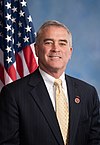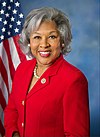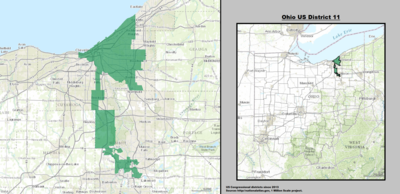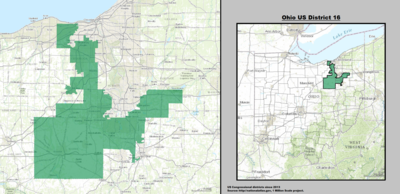| Revision as of 15:47, 24 April 2017 editChris the speller (talk | contribs)Autopatrolled, Extended confirmed users, Pending changes reviewers867,387 editsm →See also: replaced: 19th Century → 19th-century using AWB← Previous edit | Revision as of 23:20, 8 May 2017 edit undoCaleb Illinois (talk | contribs)3 edits Eliminated blatant biasTag: references removedNext edit → | ||
| Line 1: | Line 1: | ||
| [[File:Ohio Congressional Districts, 113th Congress.tif|350px|thumb|right|<center>'''Ohio's congressional districts since 2013'''<ref>{{cite web|title=The national atlas|url=http://nationalatlas.gov/printable/congress.html | [[File:Ohio Congressional Districts, 113th Congress.tif|350px|thumb|right|<center>'''Ohio's congressional districts since 2013'''<ref>{{cite web|title=The national atlas|url=http://nationalatlas.gov/printable/congress.html | ||
| |publisher=nationalatlas.gov|accessdate=February 22, 2014}}</ref></center>]] | |publisher=nationalatlas.gov|accessdate=February 22, 2014}}</ref></center>]] | ||
| ''']''' is divided into 16 ]s, each represented by a member of the ]. After the ], Ohio lost two House seats due to slow population growth compared to the national average,<ref name=cantonrep>{{cite news|last1=Wang|first1=Robert|title=Census costs Ohio two seats in Congress|url=http://www.cantonrep.com/article/20101221/NEWS/312219842|accessdate=4 November 2015|publisher=The Canton Repository|date=2010-12-21}}</ref> and a new map |
''']''' is divided into 16 ]s, each represented by a member of the ]. After the ], Ohio lost two House seats due to slow population growth compared to the national average,<ref name=cantonrep>{{cite news|last1=Wang|first1=Robert|title=Census costs Ohio two seats in Congress|url=http://www.cantonrep.com/article/20101221/NEWS/312219842|accessdate=4 November 2015|publisher=The Canton Repository|date=2010-12-21}}</ref> and a new map was signed into law on September 26, 2011. | ||
| ==Current districts and representatives== | ==Current districts and representatives== | ||
Revision as of 23:20, 8 May 2017

Ohio is divided into 16 congressional districts, each represented by a member of the United States House of Representatives. After the 2010 Census, Ohio lost two House seats due to slow population growth compared to the national average, and a new map was signed into law on September 26, 2011.
Current districts and representatives
List of members of the Ohio United States House delegation, their terms, their district boundaries, and the districts' political rating according to the CPVI. The delegation has a total of 16 members, with 12 Republicans and 4 Democrats.
| District | Representative | Party | CPVI | Incumbency | District map |
|---|---|---|---|---|---|
| 1st |  Steve Chabot (R-Cincinnati) Steve Chabot (R-Cincinnati)
|
Republican | R+5 | January 3, 2011 – present | 
|
| 2nd |  Brad Wenstrup (R-Cincinnati) Brad Wenstrup (R-Cincinnati)
|
Republican | R+9 | January 3, 2013 – present | 
|
| 3rd |  Joyce Beatty (D-Columbus) Joyce Beatty (D-Columbus)
|
Democratic | D+19 | January 3, 2013 – present | 
|
| 4th |  Jim Jordan (R-Lima) Jim Jordan (R-Lima)
|
Republican | R+14 | January 3, 2007 – present | 
|
| 5th |  Bob Latta (R-Bowling Green) Bob Latta (R-Bowling Green)
|
Republican | R+11 | December 11, 2007 – present | 
|
| 6th |  Bill Johnson (R-Marietta) Bill Johnson (R-Marietta)
|
Republican | R+16 | January 3, 2011 – present | 
|
| 7th |  Bob Gibbs (R-Washington Township, Holmes County) Bob Gibbs (R-Washington Township, Holmes County)
|
Republican | R+12 | January 3, 2011 – present | 
|
| 8th |  Warren Davidson (R-Troy) Warren Davidson (R-Troy)
|
Republican | R+17 | June 9, 2016 – present | 
|
| 9th |  Marcy Kaptur (D-Toledo) Marcy Kaptur (D-Toledo)
|
Democratic | D+14 | January 3, 1983 – present | 
|
| 10th |  Mike Turner (R-Dayton) Mike Turner (R-Dayton)
|
Republican | R+4 | January 3, 2003 – present | 
|
| 11th |  Marcia Fudge (D-Cleveland) Marcia Fudge (D-Cleveland)
|
Democratic | D+32 | November 18, 2008 – present | 
|
| 12th |  Pat Tiberi (R-Mansfield) Pat Tiberi (R-Mansfield)
|
Republican | R+7 | January 3, 2001 – present | 
|
| 13th |  Tim Ryan (D-Akron) Tim Ryan (D-Akron)
|
Democratic | D+7 | January 3, 2003 – present | 
|
| 14th |  David Joyce (R-Richmond Heights) David Joyce (R-Richmond Heights)
|
Republican | R+5 | January 3, 2013 – present | 
|
| 15th |  Steve Stivers (R-Columbus) Steve Stivers (R-Columbus)
|
Republican | R+7 | January 3, 2011 – present | 
|
| 16th |  Jim Renacci (R-Wadsworth) Jim Renacci (R-Wadsworth)
|
Republican | R+8 | January 3, 2011 – present | 
|
Historical district boundaries
Obsolete districts
- Ohio's at-large congressional district
- Ohio's 17th congressional district
- Ohio's 18th congressional district
- Ohio's 19th congressional district
- Ohio's 20th congressional district
- Ohio's 21st congressional district
- Ohio's 22nd congressional district
- Ohio's 23rd congressional district
- Ohio's 24th congressional district
See also
- List of United States congressional districts
- United States congressional delegations from Ohio
- History of 19th-century congressional redistricting in Ohio
References
- "The national atlas". nationalatlas.gov. Retrieved February 22, 2014.
- Wang, Robert (2010-12-21). "Census costs Ohio two seats in Congress". The Canton Repository. Retrieved 4 November 2015.
| Ohio's congressional districts | |
|---|---|
|
